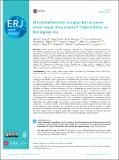Files in this item
All nonadherence is equal but is some more equal than others? Tuberculosis in the digital era
Item metadata
| dc.contributor.author | Stagg, Helen R. | |
| dc.contributor.author | Flook, Mary | |
| dc.contributor.author | Martinecz, Antal | |
| dc.contributor.author | Kielmann, Karina | |
| dc.contributor.author | Abel Zur Wiesch, Pia | |
| dc.contributor.author | Karat, Aaron S. | |
| dc.contributor.author | Lipman, Marc C.I. | |
| dc.contributor.author | Sloan, Derek James | |
| dc.contributor.author | Walker, Elizabeth F. | |
| dc.contributor.author | Fielding, Katherine L. | |
| dc.date.accessioned | 2020-11-09T11:30:01Z | |
| dc.date.available | 2020-11-09T11:30:01Z | |
| dc.date.issued | 2020-11-02 | |
| dc.identifier | 271100094 | |
| dc.identifier | b60b2865-6b50-438f-978f-2948d271d284 | |
| dc.identifier | 000603682700059 | |
| dc.identifier | 85103317169 | |
| dc.identifier.citation | Stagg , H R , Flook , M , Martinecz , A , Kielmann , K , Abel Zur Wiesch , P , Karat , A S , Lipman , M C I , Sloan , D J , Walker , E F & Fielding , K L 2020 , ' All nonadherence is equal but is some more equal than others? Tuberculosis in the digital era ' , ERJ Open Research , vol. 6 , no. 4 , 00315-2020 . https://doi.org/10.1183/23120541.00315-2020 | en |
| dc.identifier.issn | 2312-0541 | |
| dc.identifier.other | ORCID: /0000-0002-7888-5449/work/83086025 | |
| dc.identifier.uri | https://hdl.handle.net/10023/20930 | |
| dc.description | Funding: H.R. Stagg and M. Flook are supported by the Medical Research Council (grant number MR/R008345/1). H.R. Stagg, A.S. Karat and M.C.I. Lipman are supported by the National Institute for Health Research (NIHR) Health Technology Assessment Programme, UK (grant number 16/88/06). | en |
| dc.description.abstract | Adherence to treatment for tuberculosis (TB) has been a concern for many decades, resulting in the World Health Organization's recommendation of the direct observation of treatment in the 1990s. Recent advances in digital adherence technologies (DATs) have renewed discussion on how to best address nonadherence, as well as offering important information on dose-by-dose adherence patterns and their variability between countries and settings. Previous studies have largely focussed on percentage thresholds to delineate sufficient adherence, but this is misleading and limited, given the complex and dynamic nature of adherence over the treatment course. Instead, we apply a standardised taxonomy – as adopted by the international adherence community – to dose-by-dose medication-taking data, which divides missed doses into 1) late/noninitiation (starting treatment later than expected/not starting), 2) discontinuation (ending treatment early), and 3) suboptimal implementation (intermittent missed doses). Using this taxonomy, we can consider the implications of different forms of nonadherence for intervention and regimen design. For example, can treatment regimens be adapted to increase the “forgiveness” of common patterns of suboptimal implementation to protect against treatment failure and the development of drug resistance? Is it reasonable to treat all missed doses of treatment as equally problematic and equally common when deploying DATs? Can DAT data be used to indicate the patients that need enhanced levels of support during their treatment course? Critically, we pinpoint key areas where knowledge regarding treatment adherence is sparse and impeding scientific progress. | |
| dc.format.extent | 13 | |
| dc.format.extent | 1033670 | |
| dc.language.iso | eng | |
| dc.relation.ispartof | ERJ Open Research | en |
| dc.subject | QR Microbiology | en |
| dc.subject | RM Therapeutics. Pharmacology | en |
| dc.subject | T-NDAS | en |
| dc.subject | SDG 3 - Good Health and Well-being | en |
| dc.subject | MCP | en |
| dc.subject.lcc | QR | en |
| dc.subject.lcc | RM | en |
| dc.title | All nonadherence is equal but is some more equal than others? Tuberculosis in the digital era | en |
| dc.type | Journal item | en |
| dc.contributor.institution | University of St Andrews. Infection and Global Health Division | en |
| dc.contributor.institution | University of St Andrews. School of Medicine | en |
| dc.identifier.doi | https://doi.org/10.1183/23120541.00315-2020 | |
| dc.description.status | Peer reviewed | en |
This item appears in the following Collection(s)
Items in the St Andrews Research Repository are protected by copyright, with all rights reserved, unless otherwise indicated.

